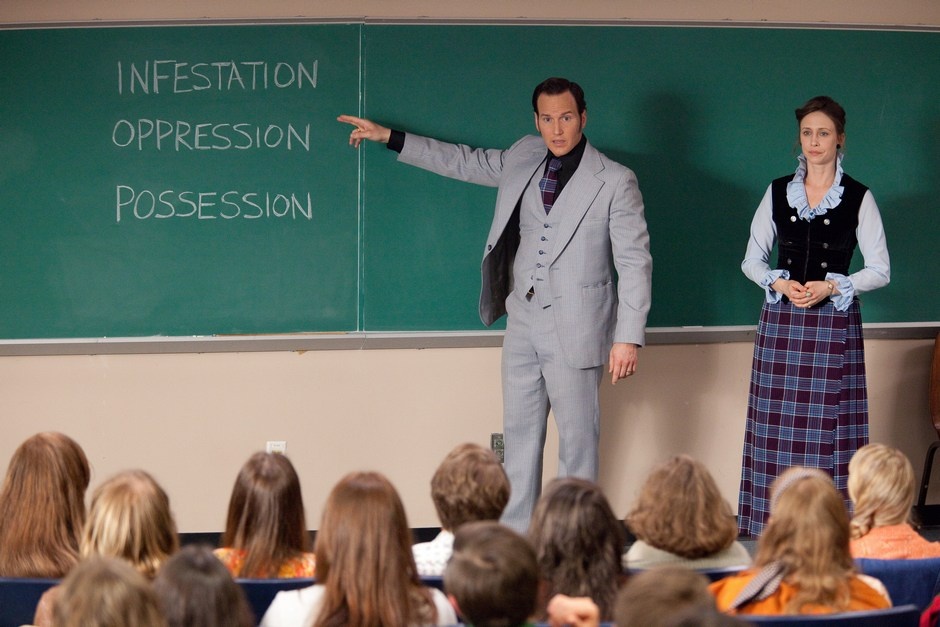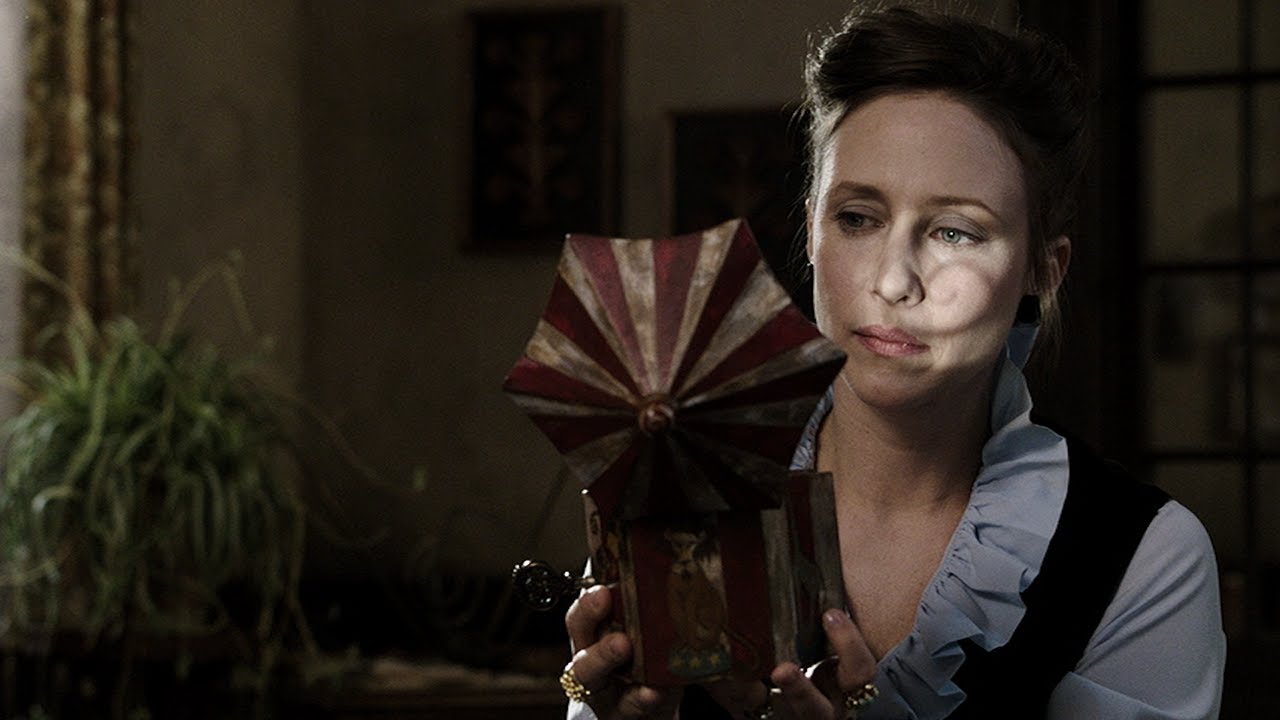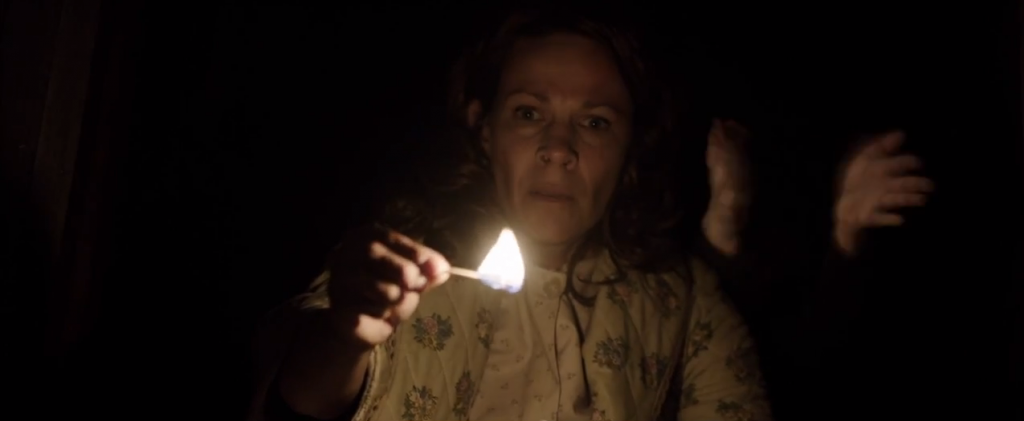The Conjuring Review: A Gripping, Tense and Overall Masterful Genre Revival
Like comedy, the horror genre can be a very subjective beast, finding or missing its mark as much do to its craft and execution as it does the particular individual who plops themselves into a theater seat. If something isn’t scary to someone – someone who earnest believes that of course – then a fright flick has failed at its core intent. Then we have something like James Wan’s
The Conjuring, an artful, confident throwback that succeeds in maintaining a high tensile level of pressure on our senses, crafting vital jump scares, a potent human element and all encompassing technical prowess. This is the type of brave, but stripped down horror filmmaking that forces you to analyze other elements besides just the full effectiveness of its frightening intent. Plus it’s scary as hell.
The Conjuring completes a modern supernatural horror film trifecta started with Wan’s own
Insidious in 2010 and bridged by last year’s unsettling
Sinister. With these films the genre has proven that this is far from a dead, now inherently clichéd area of cinema and this effort is perhaps the best of all three. After breaking onto the scene in a big way with the trend setting
Saw, the director took a bit of creative detour in the eyes of most with revenge thriller
Death Sentence and supernatural doll flick
Dead Silence (which is vastly underrated by the way) before rebounding with the aforementioned
Insidious. For
The Conjuring it seems Wan has taken everything he’s learned – congealing everything he’s found to be effective – and assembled them exquisitely and with ample new flare to boot.
 The Conjuring
The Conjuring pulls its inspiration from a case file of famed demonologists and paranormal investigators the Warrens, the husband and wife team who’s other journeys inspired films such as
The Amityville Horror. Here they are played respectively by Patrick Wilson and Vera Farmiga who are now both genre regulars with roles in
Insidious and the upcoming
Chapter 2 due this year for the gentleman and
Orphan and television’s
Psycho prequel
Bates Motel for Farmiga. We’ve all seen the painful trope of priests, exorcists, psychics and every nut-job in between showing up at the eleventh hour to save a haunted family but the way they’re approached in
The Conjuring stands as one of the film’s greatest strengths.
Though it’s something that should be completely obvious out of the gate (but still something those inspired by the Warren’s stories forget) this is just as much their story as those experiencing the phenomena. In giving nearly as much screen time to this duo as it does the Perron’s (a seven family troop lead by actors Ron Livingston and Lili Taylor and their five daughters) we grow and involve with these nine individuals so when things get terrifying we not only feel just as much for everyone on screen but everyone gets a satisfying arc. It’s something so rare in most horror films. Though this dynamic is certainly not presented through these two separate camps – the fearful and the experts – but the men bond over their love of cars and their wives and the women over the unfathomable: harm befalling their children. It’s a satisfying an utterly untapped approach for the genre.

But “wait, wait” you proclaim “this is a horror movie after all, stop talking about the little girls and get to the scares!” Graciously, somewhat rude reader.
The Conjuring is creepy, intermittently nightmarish, tense, gross, unsettling, and in its purest form, scary. This is the type of film that dares you not to hug yourself or laugh nervously in the hopes you deflect some iota of the sensation of primal fear. But these emotions are never extracted in a manipulative fashion and the jump scares are orchestrated effectively through physical objects falling, bumping, banging and generally causing off-putting noises, not blaring, out of context musical chords.
The camera work is also fantastic employing every angle imaginable and even some very impressive point of view and upside-down-spin shots. It’s easily Wan’s best directed effort to date but never one that lets its style eclipse the mood. Similarly his use of sound both in the score (which utilizes your average brooding options as well as sharp, grating notes that call back to horror of days gone by) and practical noises such as a strained rope swinging or a door slamming shut. Again, it all adds to the experience and in eventually pulling of the major frights.

Like most fare of this nature, the restrained tension does take a bit of a hit heading into the finale, as subtlety is sacrificed for more overt horror to resolve the story. Thankfully this change in approach is handled with just as much aplomb and also manages to deliver one of the most effective exorcism sequences in recent memory – a victory made all the more notable thanks to the generally overexposed and silly nature of that staple. It’s not the perfect ending that the previous acts demanded but one that by no means insults the audience and still remains scary (if in a more upfront manner).
Perhaps the biggest compliment I can pay
The Conjuring is that it actually deserves a sequel. There are tales of the Warrens left to tell and the acting is uniformly strong enough that revisiting these characters would be more a treat then a chore. It takes a skilful filmmaker to take well worn themes and approaches (while avoiding gore and a high body count to boot) and make them seem as original as ever. Coming from a huge horror buff and one that experiences more disappointments then the average soul can handle, I can earnestly say
The Conjuring is one of the best ever and what can serve as a fantastic induction into the genre for the uninitiated.
 The Conjuring pulls its inspiration from a case file of famed demonologists and paranormal investigators the Warrens, the husband and wife team who’s other journeys inspired films such as The Amityville Horror. Here they are played respectively by Patrick Wilson and Vera Farmiga who are now both genre regulars with roles in Insidious and the upcoming Chapter 2 due this year for the gentleman and Orphan and television’s Psycho prequel Bates Motel for Farmiga. We’ve all seen the painful trope of priests, exorcists, psychics and every nut-job in between showing up at the eleventh hour to save a haunted family but the way they’re approached in The Conjuring stands as one of the film’s greatest strengths.
Though it’s something that should be completely obvious out of the gate (but still something those inspired by the Warren’s stories forget) this is just as much their story as those experiencing the phenomena. In giving nearly as much screen time to this duo as it does the Perron’s (a seven family troop lead by actors Ron Livingston and Lili Taylor and their five daughters) we grow and involve with these nine individuals so when things get terrifying we not only feel just as much for everyone on screen but everyone gets a satisfying arc. It’s something so rare in most horror films. Though this dynamic is certainly not presented through these two separate camps – the fearful and the experts – but the men bond over their love of cars and their wives and the women over the unfathomable: harm befalling their children. It’s a satisfying an utterly untapped approach for the genre.
The Conjuring pulls its inspiration from a case file of famed demonologists and paranormal investigators the Warrens, the husband and wife team who’s other journeys inspired films such as The Amityville Horror. Here they are played respectively by Patrick Wilson and Vera Farmiga who are now both genre regulars with roles in Insidious and the upcoming Chapter 2 due this year for the gentleman and Orphan and television’s Psycho prequel Bates Motel for Farmiga. We’ve all seen the painful trope of priests, exorcists, psychics and every nut-job in between showing up at the eleventh hour to save a haunted family but the way they’re approached in The Conjuring stands as one of the film’s greatest strengths.
Though it’s something that should be completely obvious out of the gate (but still something those inspired by the Warren’s stories forget) this is just as much their story as those experiencing the phenomena. In giving nearly as much screen time to this duo as it does the Perron’s (a seven family troop lead by actors Ron Livingston and Lili Taylor and their five daughters) we grow and involve with these nine individuals so when things get terrifying we not only feel just as much for everyone on screen but everyone gets a satisfying arc. It’s something so rare in most horror films. Though this dynamic is certainly not presented through these two separate camps – the fearful and the experts – but the men bond over their love of cars and their wives and the women over the unfathomable: harm befalling their children. It’s a satisfying an utterly untapped approach for the genre.
 But “wait, wait” you proclaim “this is a horror movie after all, stop talking about the little girls and get to the scares!” Graciously, somewhat rude reader. The Conjuring is creepy, intermittently nightmarish, tense, gross, unsettling, and in its purest form, scary. This is the type of film that dares you not to hug yourself or laugh nervously in the hopes you deflect some iota of the sensation of primal fear. But these emotions are never extracted in a manipulative fashion and the jump scares are orchestrated effectively through physical objects falling, bumping, banging and generally causing off-putting noises, not blaring, out of context musical chords.
The camera work is also fantastic employing every angle imaginable and even some very impressive point of view and upside-down-spin shots. It’s easily Wan’s best directed effort to date but never one that lets its style eclipse the mood. Similarly his use of sound both in the score (which utilizes your average brooding options as well as sharp, grating notes that call back to horror of days gone by) and practical noises such as a strained rope swinging or a door slamming shut. Again, it all adds to the experience and in eventually pulling of the major frights.
But “wait, wait” you proclaim “this is a horror movie after all, stop talking about the little girls and get to the scares!” Graciously, somewhat rude reader. The Conjuring is creepy, intermittently nightmarish, tense, gross, unsettling, and in its purest form, scary. This is the type of film that dares you not to hug yourself or laugh nervously in the hopes you deflect some iota of the sensation of primal fear. But these emotions are never extracted in a manipulative fashion and the jump scares are orchestrated effectively through physical objects falling, bumping, banging and generally causing off-putting noises, not blaring, out of context musical chords.
The camera work is also fantastic employing every angle imaginable and even some very impressive point of view and upside-down-spin shots. It’s easily Wan’s best directed effort to date but never one that lets its style eclipse the mood. Similarly his use of sound both in the score (which utilizes your average brooding options as well as sharp, grating notes that call back to horror of days gone by) and practical noises such as a strained rope swinging or a door slamming shut. Again, it all adds to the experience and in eventually pulling of the major frights.
 Like most fare of this nature, the restrained tension does take a bit of a hit heading into the finale, as subtlety is sacrificed for more overt horror to resolve the story. Thankfully this change in approach is handled with just as much aplomb and also manages to deliver one of the most effective exorcism sequences in recent memory – a victory made all the more notable thanks to the generally overexposed and silly nature of that staple. It’s not the perfect ending that the previous acts demanded but one that by no means insults the audience and still remains scary (if in a more upfront manner).
Perhaps the biggest compliment I can pay The Conjuring is that it actually deserves a sequel. There are tales of the Warrens left to tell and the acting is uniformly strong enough that revisiting these characters would be more a treat then a chore. It takes a skilful filmmaker to take well worn themes and approaches (while avoiding gore and a high body count to boot) and make them seem as original as ever. Coming from a huge horror buff and one that experiences more disappointments then the average soul can handle, I can earnestly say The Conjuring is one of the best ever and what can serve as a fantastic induction into the genre for the uninitiated.
Like most fare of this nature, the restrained tension does take a bit of a hit heading into the finale, as subtlety is sacrificed for more overt horror to resolve the story. Thankfully this change in approach is handled with just as much aplomb and also manages to deliver one of the most effective exorcism sequences in recent memory – a victory made all the more notable thanks to the generally overexposed and silly nature of that staple. It’s not the perfect ending that the previous acts demanded but one that by no means insults the audience and still remains scary (if in a more upfront manner).
Perhaps the biggest compliment I can pay The Conjuring is that it actually deserves a sequel. There are tales of the Warrens left to tell and the acting is uniformly strong enough that revisiting these characters would be more a treat then a chore. It takes a skilful filmmaker to take well worn themes and approaches (while avoiding gore and a high body count to boot) and make them seem as original as ever. Coming from a huge horror buff and one that experiences more disappointments then the average soul can handle, I can earnestly say The Conjuring is one of the best ever and what can serve as a fantastic induction into the genre for the uninitiated.